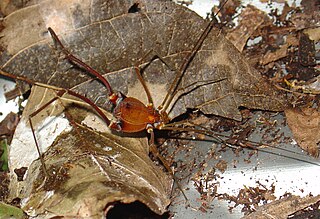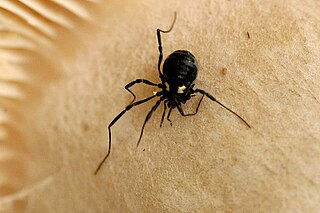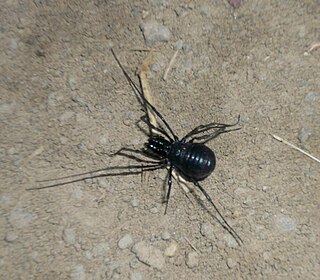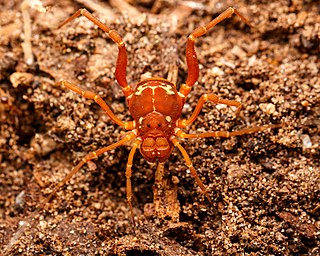
The Opiliones are an order of arachnids colloquially known as harvestmen, harvesters, harvest spiders, or daddy longlegs. As of April 2017, over 6,650 species of harvestmen have been discovered worldwide, although the total number of extant species may exceed 10,000. The order Opiliones includes five suborders: Cyphophthalmi, Eupnoi, Dyspnoi, Laniatores, and Tetrophthalmi, which were named in 2014.

Gonyleptoidea is the most diverse superfamily of the Grassatores. It includes around 2,500 species distributed in the Neotropics. They are characterized by the simplified male genitalia, with the glans free subapical in the truncus.

Cosmetidae is a family of harvestmen in the suborder Laniatores. With over 700 species, it is one of the largest families in Opiliones. They are endemic of the New World with a Nearctic-Neotropical distribution where a large fraction of the diversity of Opiliones are represented by this single family. Cosmetidae have the northern extent of their range into the USA, where a small number species occur in the southern states. However, the family is especially diverse in Mexico, Central America and northern South America; especially the Andean realms. Their range also extends further south into Argentina and southern Brazil, but they are absent in Chile. Cosmetidae are prevalent in Amazonian region, but only relatively few also occur in Brazilian Atlantic Forest. Several species are also found in the Caribbean.

The Sclerosomatidae are a family of harvestmen with about 1,300 known species. One former subfamily has been recently removed to form a new family, Globipedidae.

The Nemastomatidae are a family of harvestmen with about 170 described species in 16 recent genera. Several fossil species and genera are known.
The Stygnidae are a family of neotropical harvestmen within the suborder Laniatores.

The Cranaidae are a family of neotropical harvestmen within the suborder Laniatores.
Biantidae is a family of the harvestman infraorder Grassatores with about 130 described species.

Taracidae is a family of harvestmen in the order Opiliones. There are 4 genera and 23 described species in Taracidae.

Ischyropsalis is a genus of harvestmen in the monotypic family Ischyropsalididae, with 24 described species. They are found in Europe.
Cosmetinae is a subfamily of harvestmen in the family Cosmetidae.
Taito is a genus of harvestmen in the family Cosmetidae. The genus is endemic to the Amazon Basin in Brazil, Colombia, Ecuador and Peru.
Rhaucus is a genus of harvestmen in the family Cosmetidae. The genus is endemic to the Colombian northern Andes. There are currently seven described species in the genus.

Cynortinae is a subfamily of harvestmen in the family Cosmetidae.
Ferkeriinae is a subfamily of harvestmen in the family Cosmetidae.
Flirteinae is a subfamily of harvestmen in the family Cosmetidae.
Libitiinae is a subfamily of harvestmen in the family Cosmetidae.
Metergininae is a subfamily of harvestmen in the family Cosmetidae.
Taitoinae is a subfamily of harvestmen in the family Cosmetidae.







